-
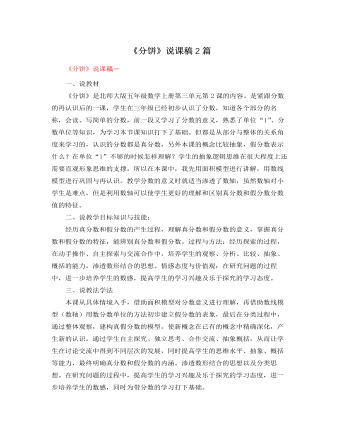
北师大版小学数学五年级上册《分饼》说课稿2篇
2、提出问题:3张大饼怎样能够平均分给唐僧师徒四人呢?每人得到大饼的多少张呢?3、揭示课题:分饼二、动手操作,探究新知:活动操作一:3张饼平均分给4个人。1、要求学生用准备好的圆纸片代表饼,剪一剪,拼一拼,画一画,小组交流自己的想法。教师巡视并进行指导。2、各小组汇报分法及分得的结果。(指名回答)第一种分法:把一张一张的饼平均分成4份,每人分每张饼的,共分一张饼的。并请学生上台演示分的整个过程。第二种分法:把3张饼叠起来,平均分成4份,每人分得3张饼的,也是张饼,请学生上台演示分的整个过程。3、演示学生两种分法的图片:4、请观察,这个分数有什么特点,分子比分母小,你还能举几个这样的例子吗?像这样的分数叫作真分数,真分数小于1。
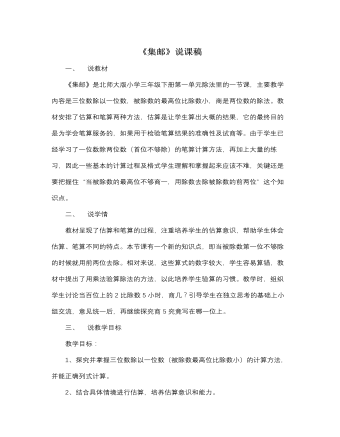
北师大版小学数学三年级下册《集邮》说课稿
《集邮》是北师大版小学三年级下册第一单元除法里的一节课,主要教学内容是三位数除以一位数,被除数的最高位比除数小,商是两位数的除法。教材安排了估算和笔算两种方法,估算是让学生算出大概的结果,它的最终目的是为学会笔算服务的,如果用于检验笔算结果的准确性及试商等。由于学生已经学习了一位数除两位数(首位不够除)的笔算计算方法,再加上大量的练习,因此一些基本的计算过程及格式学生理解和掌握起来应该不难,关键还是要把握住“当被除数的最高位不够商一,用除数去除被除数的前两位”这个知识点。二、说学情教材呈现了估算和笔算的过程,注重培养学生的估算意识,帮助学生体会估算、笔算不同的特点。本节课有一个新的知识点,即当被除数第一位不够除的时候就用前两位去除。相对来说,这些算式的数字较大,学生容易算错,教材中提出了用乘法验算除法的方法,以此培养学生验算的习惯。
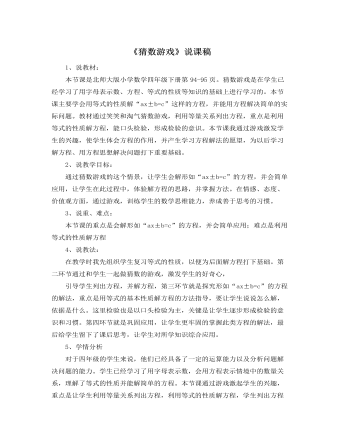
北师大版小学数学四年级下册《猜数游戏》说课稿
1、说教材:本节课是北师大版小学数学四年级下册第94-95页。猜数游戏是在学生已经学习了用字母表示数、方程、等式的性质等知识的基础上进行学习的。本节课主要学会用等式的性质解“ax±b=c”这样的方程,并能用方程解决简单的实际问题。教材通过笑笑和淘气猜数游戏,利用等量关系列出方程,重点是利用等式的性质解方程,能口头检验,形成检验的意识。本节课我通过游戏激发学生的兴趣,使学生体会方程的作用,并产生学习方程解法的愿望,为以后学习解方程、用方程思想解决问题打下重要基础。2、说教学目标:通过猜数游戏的这个情景,让学生会解形如“ax±b=c”的方程,并会简单应用,让学生在此过程中,体验解方程的思路,并掌握方法。在情感、态度、价值观方面,通过游戏,训练学生的数学思维能力,养成善于思考的习惯。3、说重、难点:本节课的重点是会解形如“ax±b=c”的方程,并会简单应用;难点是利用等式的性质解方程
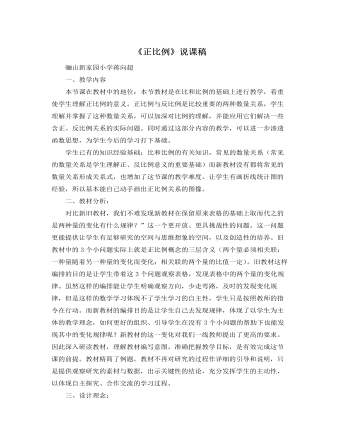
北师大版小学数学六年级下册《正比例》说课稿
{二}、努力实现扶与放的和谐统一,共同构建有效课堂。学生能自己解决的决不包办代替:学生可能完成的,充分相信学生,发挥自主探索与合作交流的优点,让学生有一个充分体验成功展示自我的舞台;学生有困难的,给予适当引导,拒绝无效探究,提高课堂效率。四、教学目标:基于对教材的理解和分析,我将该节课的教学目标定位为:1、帮助学生理解正比例的意义。用字母表示变量之间的关系,加深对正比例的认识。2、通过观察、比较、判断、归纳等方法,培养学生用事物相互联系和发展变化的观点来分析问题,使学生能够根据正比例的意义判断两种量是不是成正比例。3、学生在自主探索,合作交流中获得积极的数学情感体验,得到必要的数学思维训练。
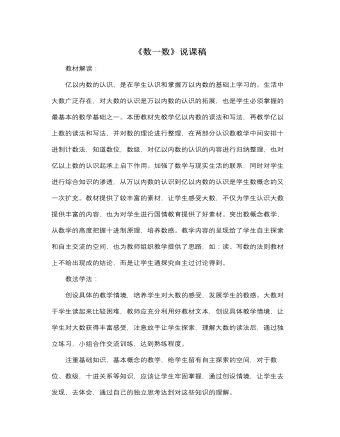
北师大版小学数学四年级上册《数一数》说课稿
亿以内数的认识,是在学生认识和掌握万以内数的基础上学习的。生活中大数广泛存在,对大数的认识是万以内数的认识的拓展,也是学生必须掌握的最基本的数学基础之一。本册教材先教学亿以内数的读法和写法,再教学亿以上数的读法和写法,并对数的理论进行整理,在两部分认识数教学中间安排十进制计数法,知道数位,数级,对亿以内数的认识的内容进行归纳整理,也对亿以上数的认识起承上启下作用。加强了数学与现实生活的联系,同时对学生进行综合知识的渗透,从万以内数的认识到亿以内数的认识是学生数概念的又一次扩充。教材提供了较丰富的素材,让学生感受大数,不仅为学生认识大数提供丰富的内容,也为对学生进行国情教育提供了好素材。突出数概念教学,从数学的高度把握十进制原理,培养数感。教学内容的呈现给了学生自主探索和自主交流的空间,也为教师组织教学提供了思路,如:读、写数的法则教材上不给出现成的结论,而是让学生通探究自主过讨论得到。
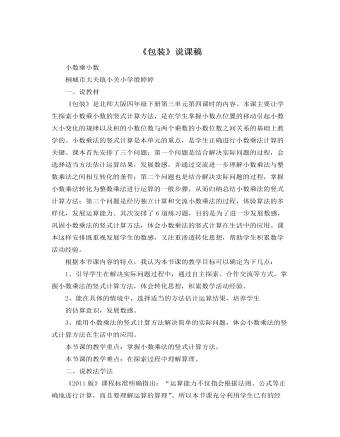
北师大版小学数学四年级下册《包装》说课稿
《包装》是北师大版四年级下册第三单元第四课时的内容。本课主要让学生探索小数乘小数的竖式计算方法,是在学生掌握小数点位置的移动引起小数大小变化的规律以及积的小数位数与两个乘数的小数位数之间关系的基础上教学的。小数乘法的竖式计算是本单元的重点,是学生正确进行小数乘法计算的关键。课本首先安排了三个问题:第一个问题是结合解决实际问题的过程,会选择适当方法估计运算结果,发展数感,并通过交流进一步理解小数乘法与整数乘法之间相互转化的条件;第二个问题也是结合解决实际问题的过程,掌握小数乘法转化为整数乘法进行运算的一般步骤,从而归纳总结小数乘法的竖式计算方法;第三个问题是经历独立计算和交流小数乘法的过程,体验算法的多样化,发展运算能力。其次安排了6道练习题,目的是为了进一步发展数感,巩固小数乘法的竖式计算方法,体会小数乘法的竖式计算在生活中的应用。

北师大版小学数学四年级下册《蚕丝》说课稿
三、说教学重点、难点重点是小数乘法的竖式计算方法和积与乘数的大小关系。难点是小数乘法中乘数末位有0的计算。四、说学情在进行本节内容学习之前,学生已经学习了整数乘法的运算规律,小数的意义及其加减法,还有小数乘法的计算规律。本节内容重点是学会把小数乘法的运算方法应用到解决实际问题中去。根据四年级学生的认知特点和课堂注意力时间有限的特点,在教学中一定要提高课堂效率五、说教法、学法在本课教学中,我采取的教学方法是:1.通过复习,回顾计算规律,并把它应用到竖式中去。2.情境展示,把数学问题直接放在实际问题中来学习并解决。3.解决问题时采用自主探索、独立思考和小组合作交流的学习方式。通过这些教学法激发学生学习的积极性和主动性,引导学生把学到的规律应用到现实生活中来解决实际问题。六、说教学过程(一)举例说明积的小数位数与乘数小数位数的关系。通过比眼力,做一做,复习前一节课所学内容,为本节课打下基础。
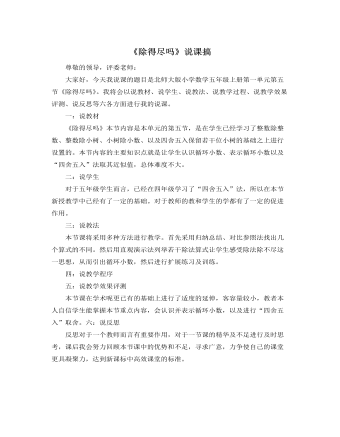
北师大版小学数学五年级上册《除得尽吗》说课稿
尊敬的领导,评委老师:大家好,今天我说课的题目是北师大版小学数学五年级上册第一单元第五节《除得尽吗》。我将会以说教材、说学生、说教法、说教学过程、说教学效果评测、说反思等六各方面进行我的说课。一:说教材《除得尽吗》本节内容是本单元的第五节,是在学生已经学习了整数除整数、整数除小树、小树除小数、以及四舍五入保留若干位小树的基础之上进行设置的。本节内容的主要知识点就是让学生认识循环小数、表示循环小数以及“四舍五入”法取其近似值,总体难度不大。二:说学生对于五年级学生而言,已经在四年级学习了“四舍五入”法,所以在本节新授教学中已经有了一定的基础。对于教师的教和学生的学都有了一定的促进作用。
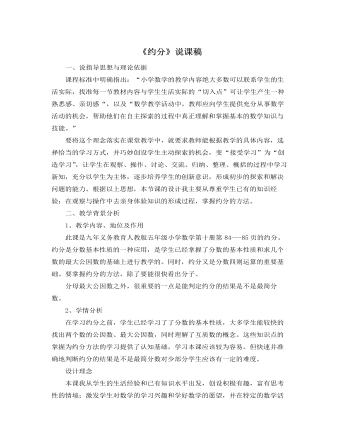
北师大版小学数学五年级上册《约分》说课稿
课程标准中明确指出:“小学数学的教学内容绝大多数可以联系学生的生活实际,找准每一节教材内容与学生生活实际的“切入点”可让学生产生一种熟悉感、亲切感“,以及“数学教学活动中,教师应向学生提供充分从事数学活动的机会,帮助他们在自主探索的过程中真正理解和掌握基本的数学知识与技能。”要将这个理念落实在课堂教学中,就要求教师能根据教学的具体内容,选择恰当的学习方式,并巧妙创设学生主动探索的机会,变“接受学习”为“创造学习”,让学生在观察、操作、讨论、交流、归纳、整理、概括的过程中学习新知,充分以学生为主体,逐步培养学生的创新意识,形成初步的探索和解决问题的能力。根据以上思想,本节课的设计我主要从尊重学生已有的知识经验;在观察与操作中去亲身体验知识的形成过程,掌握约分的方法。
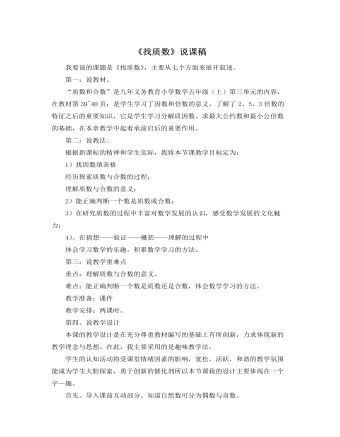
北师大版小学数学五年级上册《找质数》说课稿
第一:说教材。“质数和合数”是九年义务教育小学数学五年级(上)第三单元的内容,在教材第39~40页;是学生学习了因数和倍数的意义,了解了2、5、3倍数的特征之后的重要知识,它是学生学习分解质因数、求最大公约数和最小公倍数的基础,在本章教学中起着承前启后的重要作用。第二:说教法:根据新课标的精神和学生实际,我将本节课教学目标定为:1)找因数填表格经历探索质数与合数的过程,理解质数与合数的意义;2)能正确判断一个数是质数或合数;3)在研究质数的过程中丰富对数学发展的认识,感受数学发展的文化魅力;4)、在猜想——验证——概括——理解的过程中体会学习数学的乐趣,积累数学学习的方法。第三:说教学重难点重点:理解质数与合数的意义。难点:能正确判断一个数是质数还是合数,体会数学学习的方法。教学准备:课件教学安排:两课时。
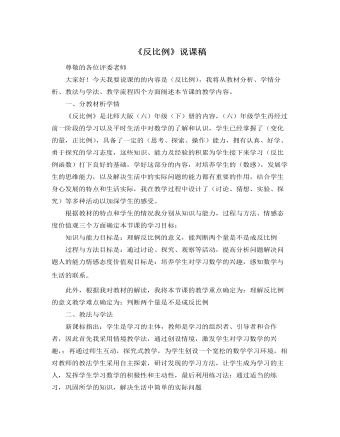
北师大版小学数学六年级下册《反比例》说课稿
知识与能力目标是:理解反比例的意义,能判断两个量是不是成反比例过程与方法目标是:通过讨论、探究、观察等活动,提高分析问题解决问题人的能力情感态度价值观目标是:培养学生对学习数学的兴趣,感知数学与生活的联系。此外,根据我对教材的解读,我将本节课的教学重点确定为:理解反比例的意义教学难点确定为:判断两个量是不是成反比例二、教法与学法新课标指出:学生是学习的主体,教师是学习的组织者、引导者和合作者,因此首先我采用情境教学法,通过创设情境,激发学生对学习数学的兴趣,;再通过师生互动,探究式教学,为学生创设一个宽松的数学学习环境,相对教师的教法学生采用自主探索,研讨发现的学习方法,让学生成为学习的主人,发挥学生学习数学的积极性和主动性,最后利用练习法:通过适当的练习,巩固所学的知识,解决生活中简单的实际问题
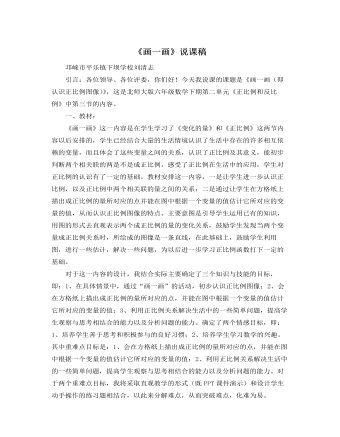
北师大版小学数学六年级下册《画一画》说课稿
一、教材:《画一画》这一内容是在学生学习了《变化的量》和《正比例》这两节内容以后安排的,学生已经结合大量的生活情境认识了生活中存在的许多相互依赖的变量,而且体会了这些变量之间的关系,认识了正比例及其意义,能初步判断两个相关联的两是不是成正比例,感受了正比例在生活中的应用,学生对正比例的认识有了一定的基础。教材安排这一内容,一是让学生进一步认识正比例,以及正比例中两个相关联的量之间的关系;二是通过让学生在方格纸上描出成正比例的量所对应的点并能在图中根据一个变量的值估计它所对应的变量的值,从而认识正比例图像的特点。主要意图是引导学生运用已有的知识,用图的形式去直观表示两个成正比例的量的变化关系,鼓励学生发现当两个变量成正比例关系时,所绘成的图像是一条直线,在此基础上,鼓励学生利用图,进行一些估计,解决一些问题,为以后进一步学习正比例函数打下一定的基础。

人教版高中英语必修4Body Language说课稿4篇
Textbook: Senior English for China (Book 4), by Liu Daoyi Time Allotment: 1 period (40 minutes)Date: March 20, 2014Teaching aids: blackboard, Multi-media, Power Point, chalk I. Text Analysis (教材分析)This unit is about body language, and the text selected in the reading part demonstrates the difference and similarity of body language in many parts of the world. Through learning this passage, students are required to raise their awareness of using body language in different parts of the world. As body language is closely related to our daily life, it is easy to arouse students’ interest in learning this text. Reading skills and speaking training are designed around the text.II. Teaching Objectives (教学目标)By the end of the lesson, students will be able to:1. Language Skill Objective(语言技能目标): develop reading ability (skimming and scanning)as well as speaking ability.2. Cultural Knowledge Objective(文化知识目标): know about the cultural differences of using body language.3. Affective Objective(情感目标): increase students’ awareness of using body language correctly in different cultures. III.Teaching Focuses and Difficulties(教学重点和难点)1. Teaching Focuses(教学重点): the difference and similarity of body language in many parts of the world.2. Teaching Difficulties(教学难点): develop students’ reading abilities of skimming and scanning and ask the students to show their opinions with fluent English.

人教版高中英语必修1English around the world说课稿
(3)v. 给:提出;展现,显现present sb. with sth. ; present sth. to sb. 把. . 交给;颁发;授予present sth. (for sth. )/present sth. to sb. e. g. Om his birthday, his friends presented him a collection of stamps. 在他生日时,他的朋友们送给他一套邮票作为礼物。The sword was presented by the family to the museum. 这家人把宝剑捐赠给了博物馆。The committee will present the final report to Parliament in June. 委员会将在六月向议会提交最后的报告。You need to present yourself better. 你需要更善于展现自己。It is essential that we present a united front. 至关重要的是我们要表现得更加团结。Step 4 ConsolidationT:Now that we have got a general idea of these words and phrases. Lets make up some sentences using them to master them. Suggested sentences:1. Your duties include typing letters and answering the telephone. 2. It is one of the greatest roles that she has played. 3. A large number of people have applied for the job. 4. The number of the panda is declining. 5. I'11 go there, even if I have to walk. 6. He came up to me to ask for a light. 7. The novel is about a family who can't communicate with each other. 8. He based his plan on interests of most people. 9. Why doesn't he make use of his singing talent?Step 5 Summary and homeworkT:Today we dealt with several new words and phrases. After class I hope that youcan read them again and again to keep them in mind. That's all for today. You aredismissed.

人教版高中英语必修2Computers说课稿3篇
一. 教材分析1. 本单元的中心话题是“计算机(Computers)”,内容涉及计算机的发展历史,计算机的应用等。本节课是该单元的第一课时,我将Warming up, Pre-reading and Comprehending这四部分整合为一节精读课。其中。Reading部分是题为WHO AM I?的文章,以第一人称的拟人手法介绍了计算机发长演变的历史和计算机在各个领域的应用,其主旨是表达计算机的发展变化之快以及在生活中用途之广。而Warming up部分以图片的形式展现了计算机的发展历程;Pre-reading中的问题和排序分别是为了预测语篇的内容和测试学生对计算机历史了解的情况;Comprehending则通过各项练习训练学生的阅读技能,从而加深对文章的理解。可见这几部分是一个有机的整体。2. 教学目标:1) 语言目标:重点词汇及短语:abacus, calculate, calculator, PC, laptop, PDA, robot, analytical, technological, universal, mathematical, artificial, intelligent, network, explore, in common, as a result.重点句子:a. My real father was Alan Turing, who in 1963 wrote a book to describe how computers could be made to work, and build a “universal machine” to solve any mathematical problem.

人教版高中英语必修2Cultural Relics说课稿2篇
Ⅲ. Analysis of the teaching material:The topic of this unit is cultural relics. Students are quite interested in topics about different cultures around the world. This is the second period of the whole unit. As a reading class, the passage mainly talks about the history of the amber room (how it was made, sent as a gift, lost and rebuilt).According to the new national curriculum, when teaching reading, much emphasis should be put on training the students’ reading skills.Ⅳ. Teaching objectives1. Language objectives:1) Students are required to master the key words and phrases occurred in the passage (e.g. amazing, decorate, belong, in return, less than etc.)2) Students are required to learn the attributive clause and acquire the sentence pattern.2. 1) Students are required to describe a certain thing by using the new sentence patterns.2) Students are required to master two kinds of reading skills—skimming and scanning, and learn to use them in their daily reading.3. 1) Students are required to know the history of the amber room.2) Students are required to appreciate cultural relics and understand the importance of protecting them.Ⅴ. Teaching important and difficult points1) the new words, phrases, and sentence pattern in the course of reading.2) Teaching difficult point: Help the students master two kinds of reading skills—skimmingand scanning and learn to apply them in daily use.Ⅵ. Teaching methods:Task-based method & Top-down model Ⅶ. Teaching aids: PPT, pictures, blackboard Ⅷ. Teaching procedure:

人教版高中英语必修3Astronomy the science of the stars说课稿3篇
Step 2 Pre-listeningAfter students finish their discussion, I will show a picture of Newton and ask them: Who is him? What is he famous for? Could you find out some words to describe him? Maybe students will answer that he is genius for his finding of theGravitation, making a great contribution to the progress of human being. At that time I will show another two pictures of Einstein and Hawking, letting students guess who they are and write down their idea about the Gravitation. For I have arranged them to search more information about the gravity before this class, Students have beenfamiliar with the topic and will not be afraid about this abstract conception, which is helpful for their listening.Step 3 While-listeningIn this step, students will be required to listen the material for three times. The first and listening is extensive listening and the second and third listening is intensive listening. In the first time, They are required to listen a material including Part 1 and Part 2 and choose the best summary of the listening text. After they choose the right answer, They also need work in group to explain what is wrong with the others. Then I will make a conclusion that we should pay attention to the first paragraph and last paragraph and some keys to get the main idea. By doing this, their capacity of generalization will have a great improvement.Before the second listening, I will ask students to scan the blank on the power point quickly and ask them to note down some key words .Then ask them to listen to the Part 1again and fill the first column of the chart. Maybe some students just show the ideas of these three scientists an still can’t catch their development of gravity. Therefore, I will ask them to listen to Part 2 again and fill in the rest. After finish the listening, I will give them ten minutes to discuss with their partner. I will also guidethem to improve their answers when they discuss with others.

人教版高中英语必修4A taste of English Humor说课稿3篇
Then I would ask them to think of a funny English or Chinese and tell it to partners. While telling stories, they can use expressions and some acting to help make the story funny. 5 minutes would be given to do this.Those stories they told there will be the material for their writing. Soletting them tell it at first is helpful. And they can make a difference between telling a funny story and writing it down. Generally speaking, it is difficult forstudents to write well because they don’t know what to write and how to write. Asking them to tell their own stories at first can help them come up with what to write.After their telling, I would invite someone to share his/her story with all of us and I would write it down on the blackboard.This example story would be used as a sample to illustrate the format of funny story. Different from a story from teacher or textbook, a story from students can obviously become a interesting material to draw students’ attention.Then I would ask the whole class to put this story into several parts. It might be a little bit difficult for them. So I would ask them to find out whether all the sentences are necessary. After delete some sentences, there are 6 sentences left behind. Then they can easily put them into three parts. After interaction with students, I would teach them the right terms for each part and conclude the format of funny story.This step is the key and difficult point in my lesson. So I mainly usetask-based teaching method in this part and the task for students was divided into several stages. With the separated difficult level, students can find there are usually three parts in writing. They can also learn to write without the unnecessary parts in the process of analyzing. And then I wouldn’t rush to tell them the right terms to them directly. Instead, I would ask them to name them by their own. A confused mind is better for acquiring knowledge.While-writing:Then I would give students 7 minutes to write down this story, without other requirements.With all the preparations in pre-writing, students’ difficulties were cleared. So it would be much easier for them to write down the story within 7 minutes. There are no other requirements because students’ first writing is actually a drafting. It would be revise and edit several times later. Writing, as a skill

人教版高中英语必修4Women of achievement说课稿4篇
Good morning, distinguished judges:It’s my honor to talk about my teaching ideas with you. Today my topic is Women of Achievement. My presentation consists of six parts: the analysis of teaching material and student, teaching aims, key and difficult points, teaching and studying method, teaching procedures and blackboard design.First, let’s focus on the analysis of teaching material. This lesson is from New Senior English for China Student’s Book 4 Unit 1, the reading part. The main topic of the passage is the introduction of a student of Africanwildlife. After this lesson, the students will learn more information about her studying chimps in Africa, and their reading and speaking abilities can be developed as well.The next part is the analysis of students. My students are in senior high students. They have learnt English for many years, they’ve known many words and sentences, but their speaking and reading abilities are still not very good. So I will practice their speaking and reading abilities through different exercises.According to the New Standard Curriculum and the present situation, I set the teaching aims as follows: firstly, knowledge aims. Students can grasp some new words, such as worthwhile, move off. Moreover, students can understand the content of the passage and get familiar with the topic of studying chimps in wildlife. Secondly, ability aims. Students can use reading strategies such as skimming and scanning in reading process. Thirdly, emotional aims. Students can have the awareness of protecting animals and care about animals.Based on the above analysis, the key point of this lesson is to get the main idea and the detailed information from the passage; the difficult point is to talk about the wildlife protection and use reading strategies.

人教版高中英语必修4Theme parks说课稿3篇
The oldest and the most popular park in the worldenjoy the exciting activities thereget close to the life-size cartoon characters like Mickey Mouse and Donald Duck Step 3 Pre-reading1.What do you suppose a theme park is ?2.What do you think you can see in a theme park?(1.It is a kind of amusement park which has a certain theme – that the whole park is based on. 2.buildings, castles, statues, rare animals and birds, and so on.) Step 4 Reading ----- Theme Parks –---- Fun and More Than Fun1.Predict : Read the title and the pictures on P. 34 and PredictWhat is the meaning of the title “Theme Park – Fun and more than fun”?(The title means that theme parks are fun to visit, but that they can also be educational and can offer useful information.)2.Skimming Fast read and answer:What activities can we take in a theme park?Amusement park: Bumper car Merry-go-round slide bungee jumping Free-fall rides Horror films Pirate ship Ferris wheel roller coaster3.Scanning Read again and you will find various theme parks are mentioned in the passage . Then what are they ?Theme parks: Sports theme park History theme park Culture theme park Marine or Ocean theme Park Future park Science theme park Disneyland4.Careful reading and find the main idea of each paragraph:THEME PARKS---- entertaining/ educationalPara.1 Traditional parks are places to go for relaxation and to have time away from our busy lives.Para.2 Theme parks are different They’re large and full of things to do, see and buy.Para.3 Theme parks are built around a single idea or theme. One example is a sports park.Para.4 Another kind of theme park is historical more and cultural and can be educational.Para.5 Disneylandwas the first theme park. It is based on the fantasy life and characters of Disney’s films.Para.6 Some examples of educational theme parks include sea world parks and science parks.

